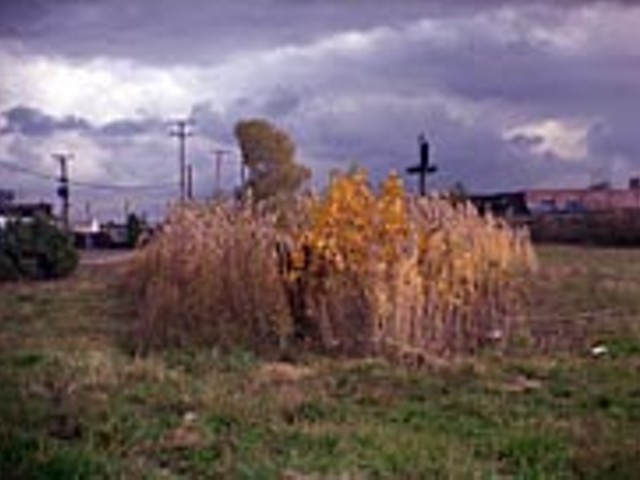Art and architecture projects representing Detroit in the international Shrinking Cities project have been chosen by the project’s three Detroit curators: Mitch Cope, director of the Tangent Gallery; Kyong Park, a New York artist and ex-Detroiter who’s created international art projects focusing on Detroit; and Dan Pitera, director of the Detroit Collaborative Design Center at the University of Detroit Mercy. The selected components include:
“Slim’s Bike”: Ben Hernandez, a producer and video artist, and Detroit artist Chris Turner found “Slim’s Bike” in the garbage after James “Slim” Thompson died in 1998. They made a documentary by interviewing people who knew Thompson or saw him riding the elaborately decorated bike, which was 10 feet long and 7 feet high. The documentary reports the folklore that Thompson, who lived in the Cass Corridor, was rumored to have done time for sex crimes, but the documentary does not prove or disprove that rumor. In the documentary, Thompson is presented as a metaphor for the two faces of Detroit: the friendly and artistic on one hand, the mysterious and deviant on the other. This paradox — the great and eccentric along with the bad and ugly — persists. How does Detroit deal with such contradictions?
“Urban Agriculture”: The Berlin-based artistic team of Ingo Vetter and Annette Weisser has done extensive research on urban agriculture in Detroit through photographs, videotaped interviews, and participation with farmers and gardeners in the city. The two intend to show models for grassroots, alternative development.
“Mobility/Immobility — The Sport”: Filmmaker Kelly Parker and UAW researcher Toni Moceri will examine how people get around, and what they do when they can’t afford a car. Parker’s video, part fiction and part documentary, compares the sport of bus riding with the sport of bull riding. Both require skill, precision, balance, courage and, above all, timing.
“Slam Poetry”: Slam poet Derrick Gilbert, professor and founder of the African and Urban Studies Department at the University of Michigan, and Robert Anderson, a filmmaker and chair of animation and digital media at the College for Creative Studies, will film five poets from Detroit’s national champion slam team.
“The Heidelberg Project”: Artist Tyree Guyton and attorney Greg Siwak will develop an installation chronicling the history of Guyton’s famous Heidelberg Project. The work will include a time line and explore the history of the neighborhood, awards, videos and the legal dealings between the city and artist. The concept is to show why the project began, its effect on the neighborhood and Detroit, who came to see it, and Guyton’s plans.
“(Eternal) — Sleep Walking”: A collaborative video project focusing on the phenomenon of the disinterment of people long buried so they can be reburied in Detroit’s suburban cemeteries. The intention is to explore the social and cultural motives and implications of this act through interviews, documentation and statistical mapping. Collaborators are Siwak, Dan Pitera, Christopher Lee, a design center intern, and Jody Huellmantel, a video artist.
“Memories”: A photo essay/interactive “happening” that will compile the stories of those who left Detroit, those who stayed, and those who have moved back to Detroit. Photos of old houses along with photos of the residents’ new houses will be exhibited. All contributors will be invited to participate in a roundtable discussion. Creators are Kyong Park, James Cope and Mitch Cope.
“Devil’s Night”: Depending on which source is cited, there were 297 or 810 fires in, on and around Devil’s Night 1984 in Detroit. The media, city officials and the fire department each had different numbers on fires during three October nights. This installation will explore the social and cultural motives and implications of the actions of Devil’s Night, now dubbed Angel’s Night. The project will probe the perceptions, statistics, stories, truths and lies.
“Self-Organized Services”: Architect Steve Vogel and researcher Kevin Bingham will produce an essay with photos and perhaps video for the Shrinking Cities catalog. As Detroit loses its tax base, it becomes more difficult to maintain city services. This project investigates people who have taken it upon themselves to provide streetlights, schools, security, community centers and garbage pickup. The researchers hypothesize that attempts by the city to institute a citywide land use plan have been stymied because neighborhood leaders don’t trust the city and don’t want to give up their power.
“Pictures of a City: An Observation”: Detroit artist Scott Hocking will focus on people who make their livings in his postindustrial neighborhood: scrappers. Rarely sleeping, working all night, the scrappers are not alcoholics, junkies or beggars. They’re too busy with the difficult work of reclaiming what has been forgotten or discarded. Hocking will use photographs of the buildings where the scrappers work and live along with documentation on their lifestyles. The portraits will be made from scrap.
Read more about Shrinking Cities:
Kyong Park and his talking house
Lisa M. Collins is the arts editor of Metro Times. E-mail [email protected]





